Distribution and Logistics Network Sustainability Report
VerifiedAdded on 2022/11/15
|20
|4615
|412
Report
AI Summary
This report delves into the strategic design of distribution and logistics networks to enhance sustainability, particularly within the process industry. It begins with an executive summary and an introduction, establishing the need for sustainable practices in supply chains, driven by stakeholder pressures and the triple bottom line. The report then reviews the literature on network design strategies, including location planning and its impact on service quality, emphasizing the importance of storage and transportation. It explores various planning levels and the role of facility location in network configuration. The report highlights the significance of emission metrics and the development of non-linear cost models. Finally, it proposes a refined model for optimizing supply chain networks for sustainability in process industries, offering insights into future trends and concluding with key takeaways.

Running head: DISTRIBUTION AND LOGISTICS NETWORK DESIGN FOR SUSTAINABILITY
Strategic design of distribution and logistics network to improve sustainability
Name of the Student
Name of the University
Authors Note
Strategic design of distribution and logistics network to improve sustainability
Name of the Student
Name of the University
Authors Note
Paraphrase This Document
Need a fresh take? Get an instant paraphrase of this document with our AI Paraphraser
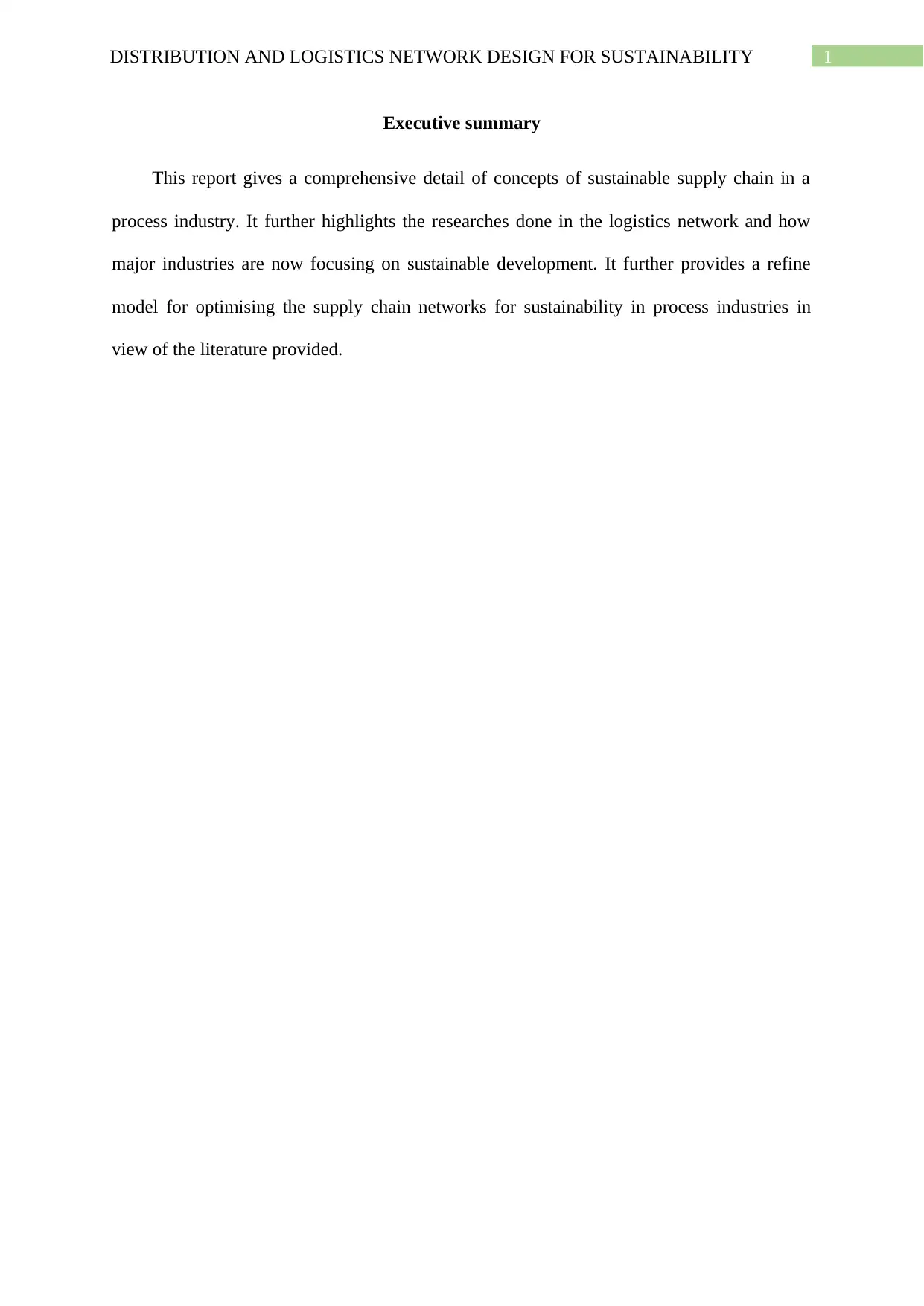
1DISTRIBUTION AND LOGISTICS NETWORK DESIGN FOR SUSTAINABILITY
Executive summary
This report gives a comprehensive detail of concepts of sustainable supply chain in a
process industry. It further highlights the researches done in the logistics network and how
major industries are now focusing on sustainable development. It further provides a refine
model for optimising the supply chain networks for sustainability in process industries in
view of the literature provided.
Executive summary
This report gives a comprehensive detail of concepts of sustainable supply chain in a
process industry. It further highlights the researches done in the logistics network and how
major industries are now focusing on sustainable development. It further provides a refine
model for optimising the supply chain networks for sustainability in process industries in
view of the literature provided.
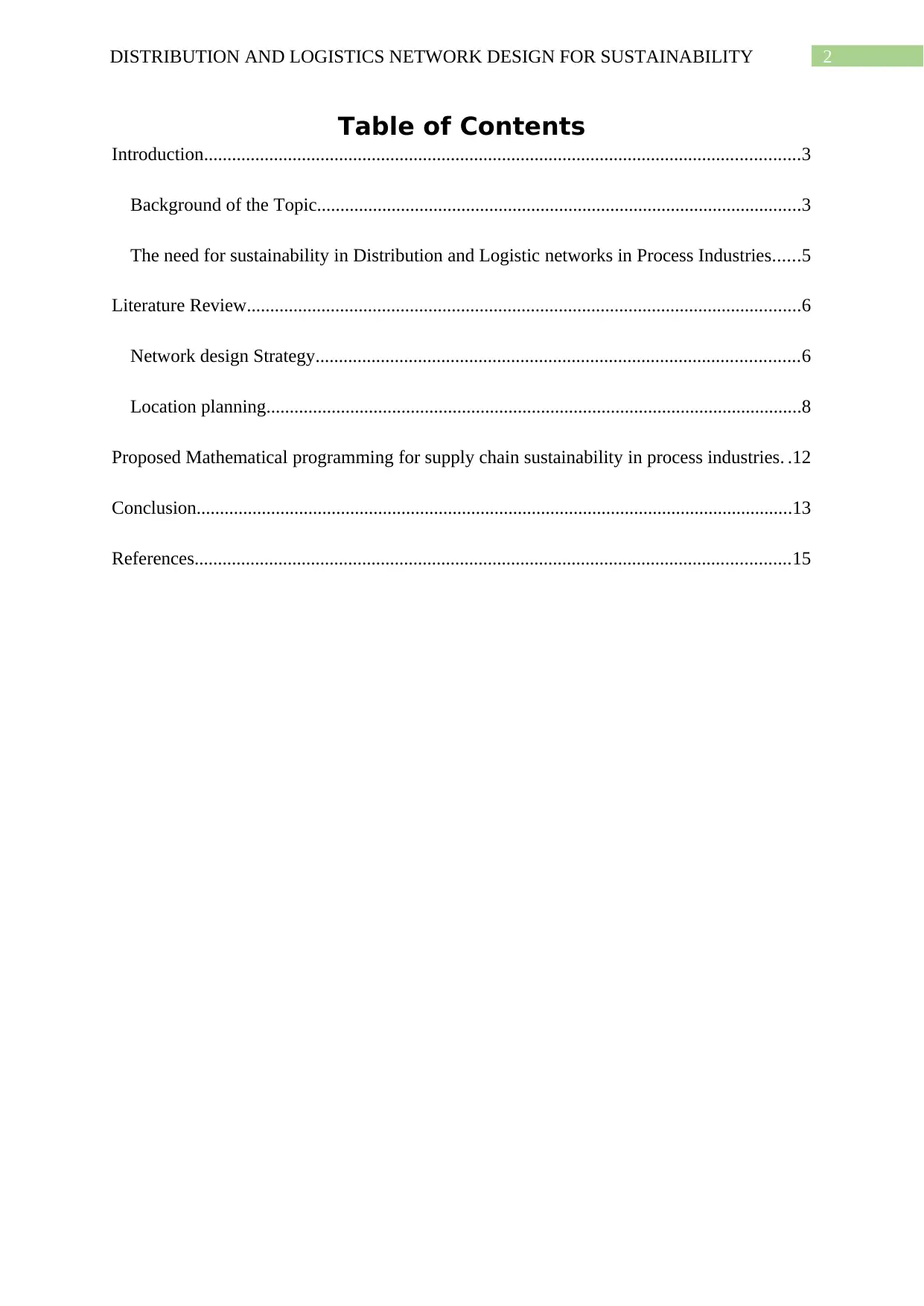
2DISTRIBUTION AND LOGISTICS NETWORK DESIGN FOR SUSTAINABILITY
Table of Contents
Introduction................................................................................................................................3
Background of the Topic........................................................................................................3
The need for sustainability in Distribution and Logistic networks in Process Industries......5
Literature Review.......................................................................................................................6
Network design Strategy........................................................................................................6
Location planning...................................................................................................................8
Proposed Mathematical programming for supply chain sustainability in process industries. .12
Conclusion................................................................................................................................13
References................................................................................................................................15
Table of Contents
Introduction................................................................................................................................3
Background of the Topic........................................................................................................3
The need for sustainability in Distribution and Logistic networks in Process Industries......5
Literature Review.......................................................................................................................6
Network design Strategy........................................................................................................6
Location planning...................................................................................................................8
Proposed Mathematical programming for supply chain sustainability in process industries. .12
Conclusion................................................................................................................................13
References................................................................................................................................15
⊘ This is a preview!⊘
Do you want full access?
Subscribe today to unlock all pages.

Trusted by 1+ million students worldwide

3DISTRIBUTION AND LOGISTICS NETWORK DESIGN FOR SUSTAINABILITY
Introduction
Background of the Topic
In past years, pressure increased by the various stakeholders, such as regulators,
suppliers, global and local communities,, customers and nongovernmental organisations
(NGOs), has been promoting the manufacturing of industry which includes sustainability
planned practices in their business for total supply chain (Fernie 2018). This increases the
firm level from local optimization to overall supply chain, including the product management
that moves from the initial sources of the raw materials to end users customers either in
forward or reverse direction, which are required for greater sustainability development. Many
theories are undertaken to examine sustainable supply chain drivers, their effects of
organizational performance, practices and competitiveness.
In supply chain, distribution network is important for storage facilities and
transportation system. Distribution network is the post manufacturing under supply chain for
goods and services, including every processing that changes raw material into final products
and deliver it to customers. Supply of goods depends upon the area or location of customers,
therefore distribution network helps in provide goods and services to long distance customer
depending on the product (Ogbo and Ukpere 2014). A manufactures plans for the distribution
of products for far areas, with the help of distribution network to serves different wholesalers,
which in turns to distribute other retailers which is last supply chain to sells goods in their
stores.
Introduction
Background of the Topic
In past years, pressure increased by the various stakeholders, such as regulators,
suppliers, global and local communities,, customers and nongovernmental organisations
(NGOs), has been promoting the manufacturing of industry which includes sustainability
planned practices in their business for total supply chain (Fernie 2018). This increases the
firm level from local optimization to overall supply chain, including the product management
that moves from the initial sources of the raw materials to end users customers either in
forward or reverse direction, which are required for greater sustainability development. Many
theories are undertaken to examine sustainable supply chain drivers, their effects of
organizational performance, practices and competitiveness.
In supply chain, distribution network is important for storage facilities and
transportation system. Distribution network is the post manufacturing under supply chain for
goods and services, including every processing that changes raw material into final products
and deliver it to customers. Supply of goods depends upon the area or location of customers,
therefore distribution network helps in provide goods and services to long distance customer
depending on the product (Ogbo and Ukpere 2014). A manufactures plans for the distribution
of products for far areas, with the help of distribution network to serves different wholesalers,
which in turns to distribute other retailers which is last supply chain to sells goods in their
stores.
Paraphrase This Document
Need a fresh take? Get an instant paraphrase of this document with our AI Paraphraser
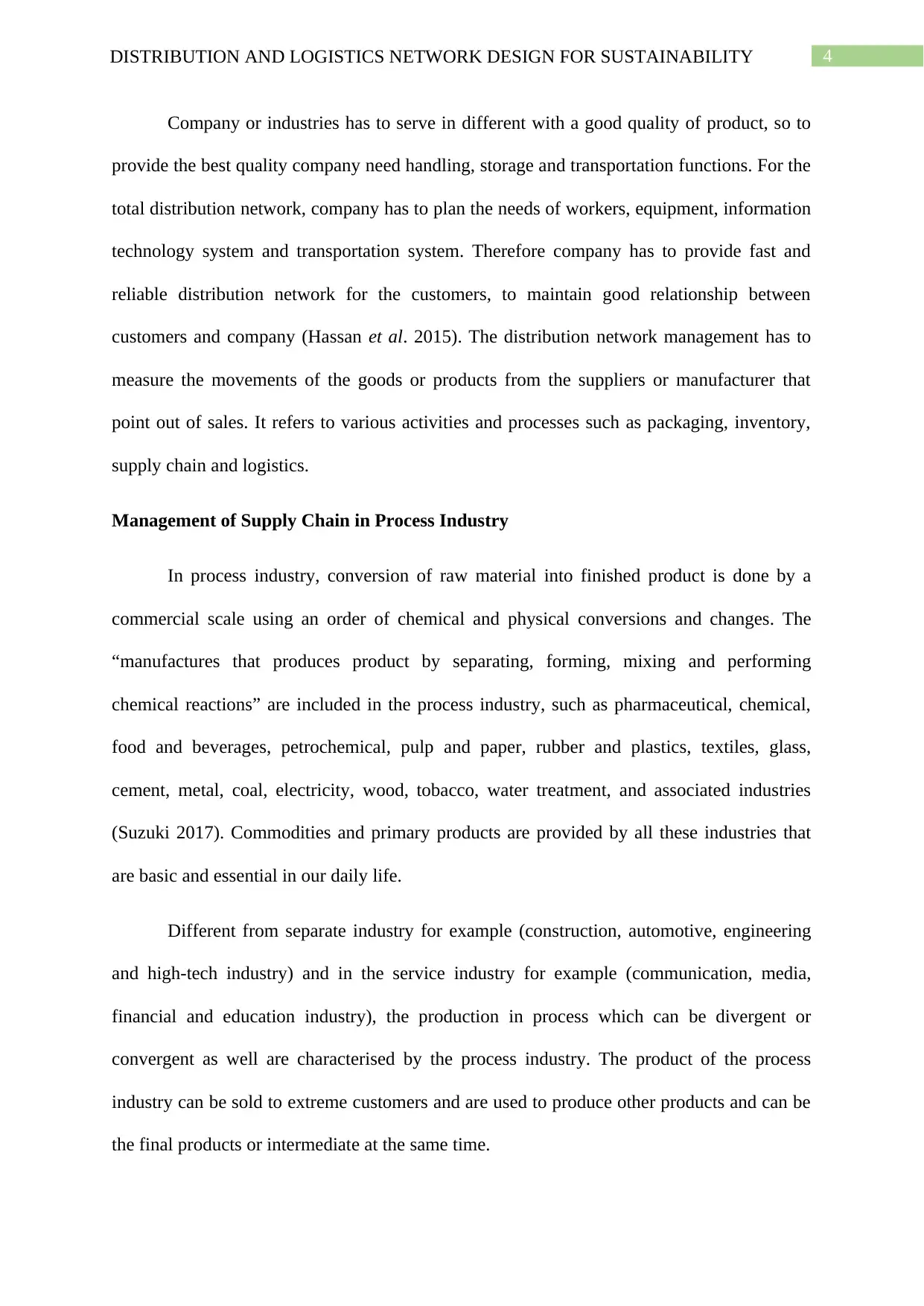
4DISTRIBUTION AND LOGISTICS NETWORK DESIGN FOR SUSTAINABILITY
Company or industries has to serve in different with a good quality of product, so to
provide the best quality company need handling, storage and transportation functions. For the
total distribution network, company has to plan the needs of workers, equipment, information
technology system and transportation system. Therefore company has to provide fast and
reliable distribution network for the customers, to maintain good relationship between
customers and company (Hassan et al. 2015). The distribution network management has to
measure the movements of the goods or products from the suppliers or manufacturer that
point out of sales. It refers to various activities and processes such as packaging, inventory,
supply chain and logistics.
Management of Supply Chain in Process Industry
In process industry, conversion of raw material into finished product is done by a
commercial scale using an order of chemical and physical conversions and changes. The
“manufactures that produces product by separating, forming, mixing and performing
chemical reactions” are included in the process industry, such as pharmaceutical, chemical,
food and beverages, petrochemical, pulp and paper, rubber and plastics, textiles, glass,
cement, metal, coal, electricity, wood, tobacco, water treatment, and associated industries
(Suzuki 2017). Commodities and primary products are provided by all these industries that
are basic and essential in our daily life.
Different from separate industry for example (construction, automotive, engineering
and high-tech industry) and in the service industry for example (communication, media,
financial and education industry), the production in process which can be divergent or
convergent as well are characterised by the process industry. The product of the process
industry can be sold to extreme customers and are used to produce other products and can be
the final products or intermediate at the same time.
Company or industries has to serve in different with a good quality of product, so to
provide the best quality company need handling, storage and transportation functions. For the
total distribution network, company has to plan the needs of workers, equipment, information
technology system and transportation system. Therefore company has to provide fast and
reliable distribution network for the customers, to maintain good relationship between
customers and company (Hassan et al. 2015). The distribution network management has to
measure the movements of the goods or products from the suppliers or manufacturer that
point out of sales. It refers to various activities and processes such as packaging, inventory,
supply chain and logistics.
Management of Supply Chain in Process Industry
In process industry, conversion of raw material into finished product is done by a
commercial scale using an order of chemical and physical conversions and changes. The
“manufactures that produces product by separating, forming, mixing and performing
chemical reactions” are included in the process industry, such as pharmaceutical, chemical,
food and beverages, petrochemical, pulp and paper, rubber and plastics, textiles, glass,
cement, metal, coal, electricity, wood, tobacco, water treatment, and associated industries
(Suzuki 2017). Commodities and primary products are provided by all these industries that
are basic and essential in our daily life.
Different from separate industry for example (construction, automotive, engineering
and high-tech industry) and in the service industry for example (communication, media,
financial and education industry), the production in process which can be divergent or
convergent as well are characterised by the process industry. The product of the process
industry can be sold to extreme customers and are used to produce other products and can be
the final products or intermediate at the same time.
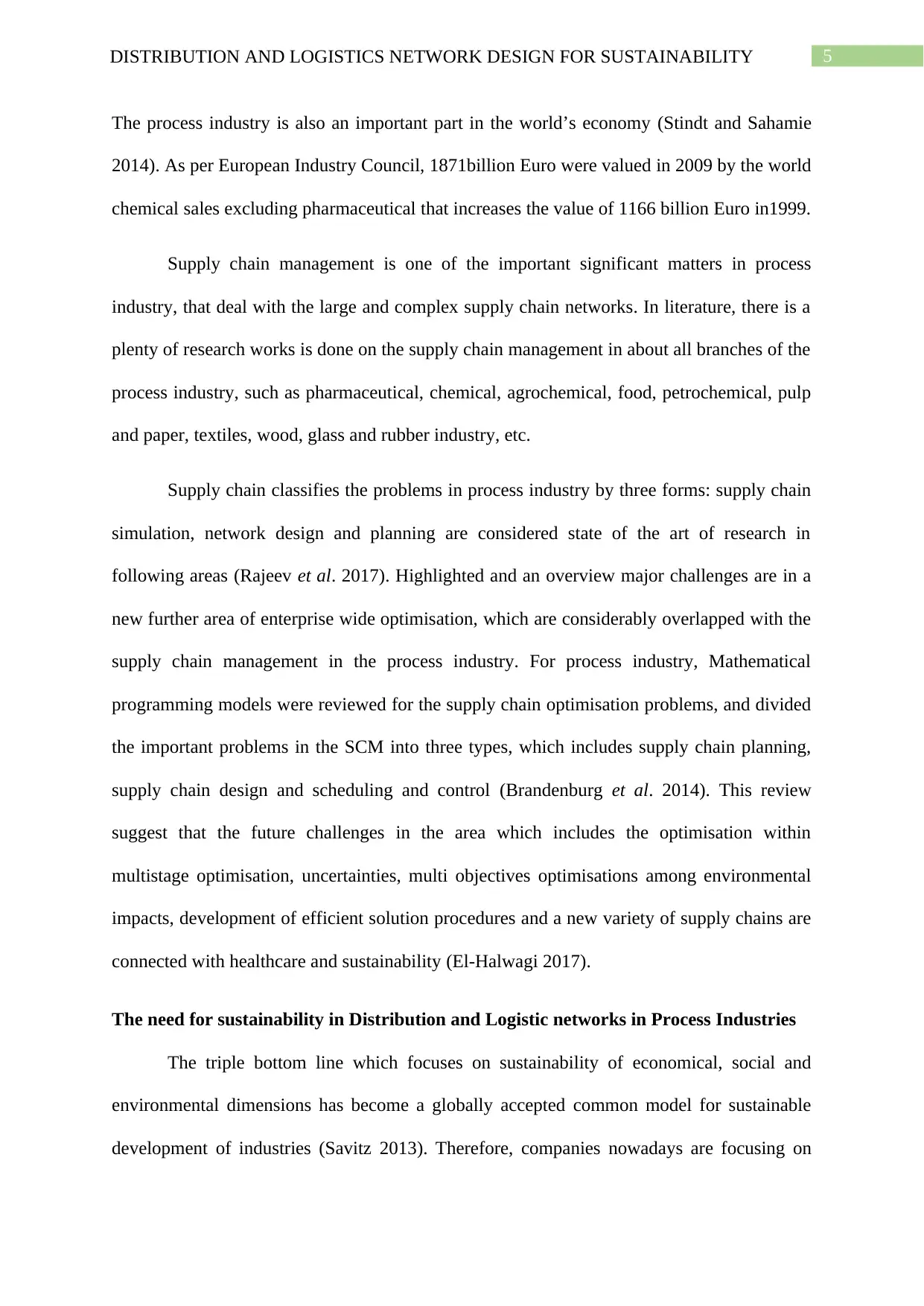
5DISTRIBUTION AND LOGISTICS NETWORK DESIGN FOR SUSTAINABILITY
The process industry is also an important part in the world’s economy (Stindt and Sahamie
2014). As per European Industry Council, 1871billion Euro were valued in 2009 by the world
chemical sales excluding pharmaceutical that increases the value of 1166 billion Euro in1999.
Supply chain management is one of the important significant matters in process
industry, that deal with the large and complex supply chain networks. In literature, there is a
plenty of research works is done on the supply chain management in about all branches of the
process industry, such as pharmaceutical, chemical, agrochemical, food, petrochemical, pulp
and paper, textiles, wood, glass and rubber industry, etc.
Supply chain classifies the problems in process industry by three forms: supply chain
simulation, network design and planning are considered state of the art of research in
following areas (Rajeev et al. 2017). Highlighted and an overview major challenges are in a
new further area of enterprise wide optimisation, which are considerably overlapped with the
supply chain management in the process industry. For process industry, Mathematical
programming models were reviewed for the supply chain optimisation problems, and divided
the important problems in the SCM into three types, which includes supply chain planning,
supply chain design and scheduling and control (Brandenburg et al. 2014). This review
suggest that the future challenges in the area which includes the optimisation within
multistage optimisation, uncertainties, multi objectives optimisations among environmental
impacts, development of efficient solution procedures and a new variety of supply chains are
connected with healthcare and sustainability (El-Halwagi 2017).
The need for sustainability in Distribution and Logistic networks in Process Industries
The triple bottom line which focuses on sustainability of economical, social and
environmental dimensions has become a globally accepted common model for sustainable
development of industries (Savitz 2013). Therefore, companies nowadays are focusing on
The process industry is also an important part in the world’s economy (Stindt and Sahamie
2014). As per European Industry Council, 1871billion Euro were valued in 2009 by the world
chemical sales excluding pharmaceutical that increases the value of 1166 billion Euro in1999.
Supply chain management is one of the important significant matters in process
industry, that deal with the large and complex supply chain networks. In literature, there is a
plenty of research works is done on the supply chain management in about all branches of the
process industry, such as pharmaceutical, chemical, agrochemical, food, petrochemical, pulp
and paper, textiles, wood, glass and rubber industry, etc.
Supply chain classifies the problems in process industry by three forms: supply chain
simulation, network design and planning are considered state of the art of research in
following areas (Rajeev et al. 2017). Highlighted and an overview major challenges are in a
new further area of enterprise wide optimisation, which are considerably overlapped with the
supply chain management in the process industry. For process industry, Mathematical
programming models were reviewed for the supply chain optimisation problems, and divided
the important problems in the SCM into three types, which includes supply chain planning,
supply chain design and scheduling and control (Brandenburg et al. 2014). This review
suggest that the future challenges in the area which includes the optimisation within
multistage optimisation, uncertainties, multi objectives optimisations among environmental
impacts, development of efficient solution procedures and a new variety of supply chains are
connected with healthcare and sustainability (El-Halwagi 2017).
The need for sustainability in Distribution and Logistic networks in Process Industries
The triple bottom line which focuses on sustainability of economical, social and
environmental dimensions has become a globally accepted common model for sustainable
development of industries (Savitz 2013). Therefore, companies nowadays are focusing on
⊘ This is a preview!⊘
Do you want full access?
Subscribe today to unlock all pages.

Trusted by 1+ million students worldwide
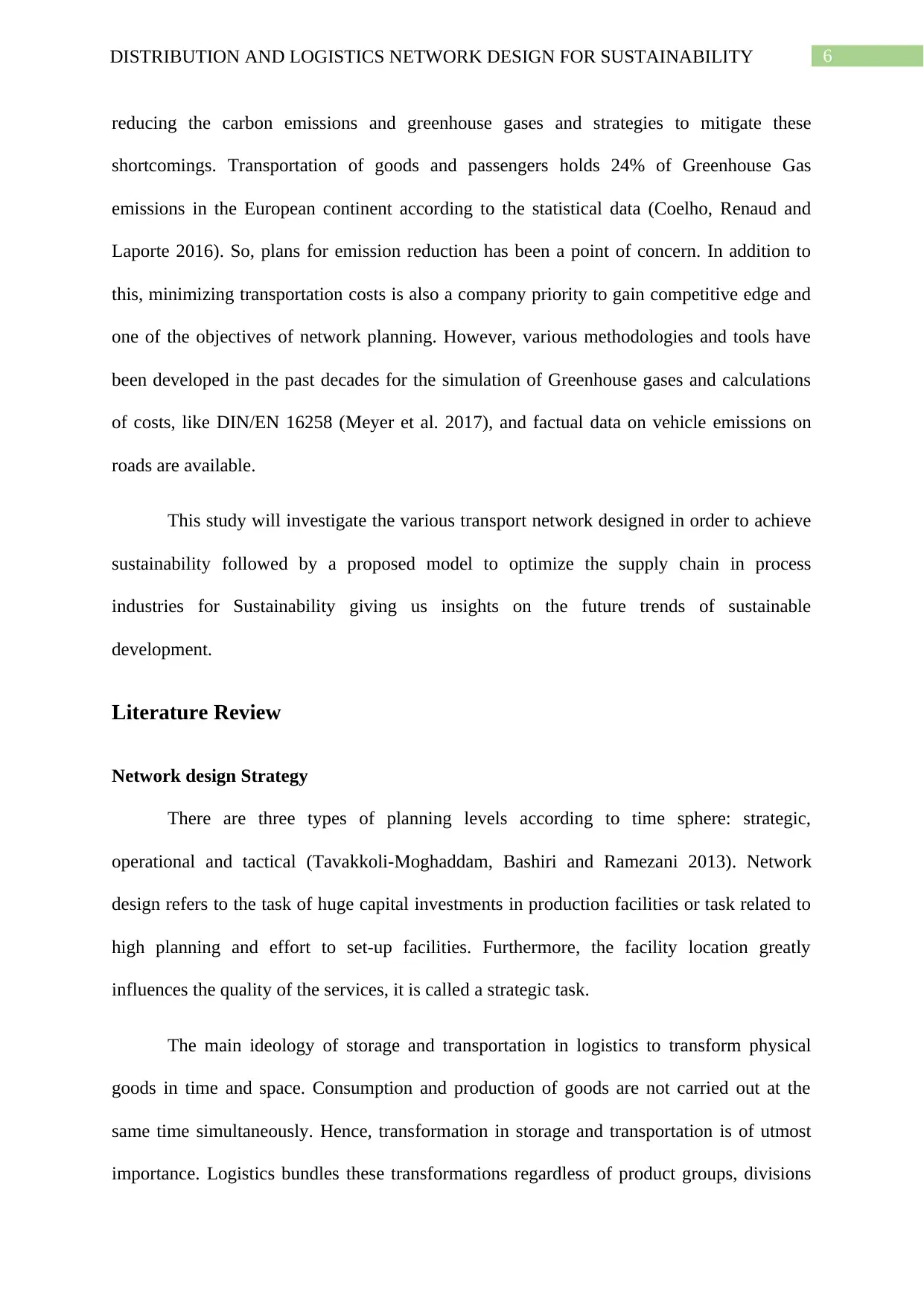
6DISTRIBUTION AND LOGISTICS NETWORK DESIGN FOR SUSTAINABILITY
reducing the carbon emissions and greenhouse gases and strategies to mitigate these
shortcomings. Transportation of goods and passengers holds 24% of Greenhouse Gas
emissions in the European continent according to the statistical data (Coelho, Renaud and
Laporte 2016). So, plans for emission reduction has been a point of concern. In addition to
this, minimizing transportation costs is also a company priority to gain competitive edge and
one of the objectives of network planning. However, various methodologies and tools have
been developed in the past decades for the simulation of Greenhouse gases and calculations
of costs, like DIN/EN 16258 (Meyer et al. 2017), and factual data on vehicle emissions on
roads are available.
This study will investigate the various transport network designed in order to achieve
sustainability followed by a proposed model to optimize the supply chain in process
industries for Sustainability giving us insights on the future trends of sustainable
development.
Literature Review
Network design Strategy
There are three types of planning levels according to time sphere: strategic,
operational and tactical (Tavakkoli-Moghaddam, Bashiri and Ramezani 2013). Network
design refers to the task of huge capital investments in production facilities or task related to
high planning and effort to set-up facilities. Furthermore, the facility location greatly
influences the quality of the services, it is called a strategic task.
The main ideology of storage and transportation in logistics to transform physical
goods in time and space. Consumption and production of goods are not carried out at the
same time simultaneously. Hence, transformation in storage and transportation is of utmost
importance. Logistics bundles these transformations regardless of product groups, divisions
reducing the carbon emissions and greenhouse gases and strategies to mitigate these
shortcomings. Transportation of goods and passengers holds 24% of Greenhouse Gas
emissions in the European continent according to the statistical data (Coelho, Renaud and
Laporte 2016). So, plans for emission reduction has been a point of concern. In addition to
this, minimizing transportation costs is also a company priority to gain competitive edge and
one of the objectives of network planning. However, various methodologies and tools have
been developed in the past decades for the simulation of Greenhouse gases and calculations
of costs, like DIN/EN 16258 (Meyer et al. 2017), and factual data on vehicle emissions on
roads are available.
This study will investigate the various transport network designed in order to achieve
sustainability followed by a proposed model to optimize the supply chain in process
industries for Sustainability giving us insights on the future trends of sustainable
development.
Literature Review
Network design Strategy
There are three types of planning levels according to time sphere: strategic,
operational and tactical (Tavakkoli-Moghaddam, Bashiri and Ramezani 2013). Network
design refers to the task of huge capital investments in production facilities or task related to
high planning and effort to set-up facilities. Furthermore, the facility location greatly
influences the quality of the services, it is called a strategic task.
The main ideology of storage and transportation in logistics to transform physical
goods in time and space. Consumption and production of goods are not carried out at the
same time simultaneously. Hence, transformation in storage and transportation is of utmost
importance. Logistics bundles these transformations regardless of product groups, divisions
Paraphrase This Document
Need a fresh take? Get an instant paraphrase of this document with our AI Paraphraser
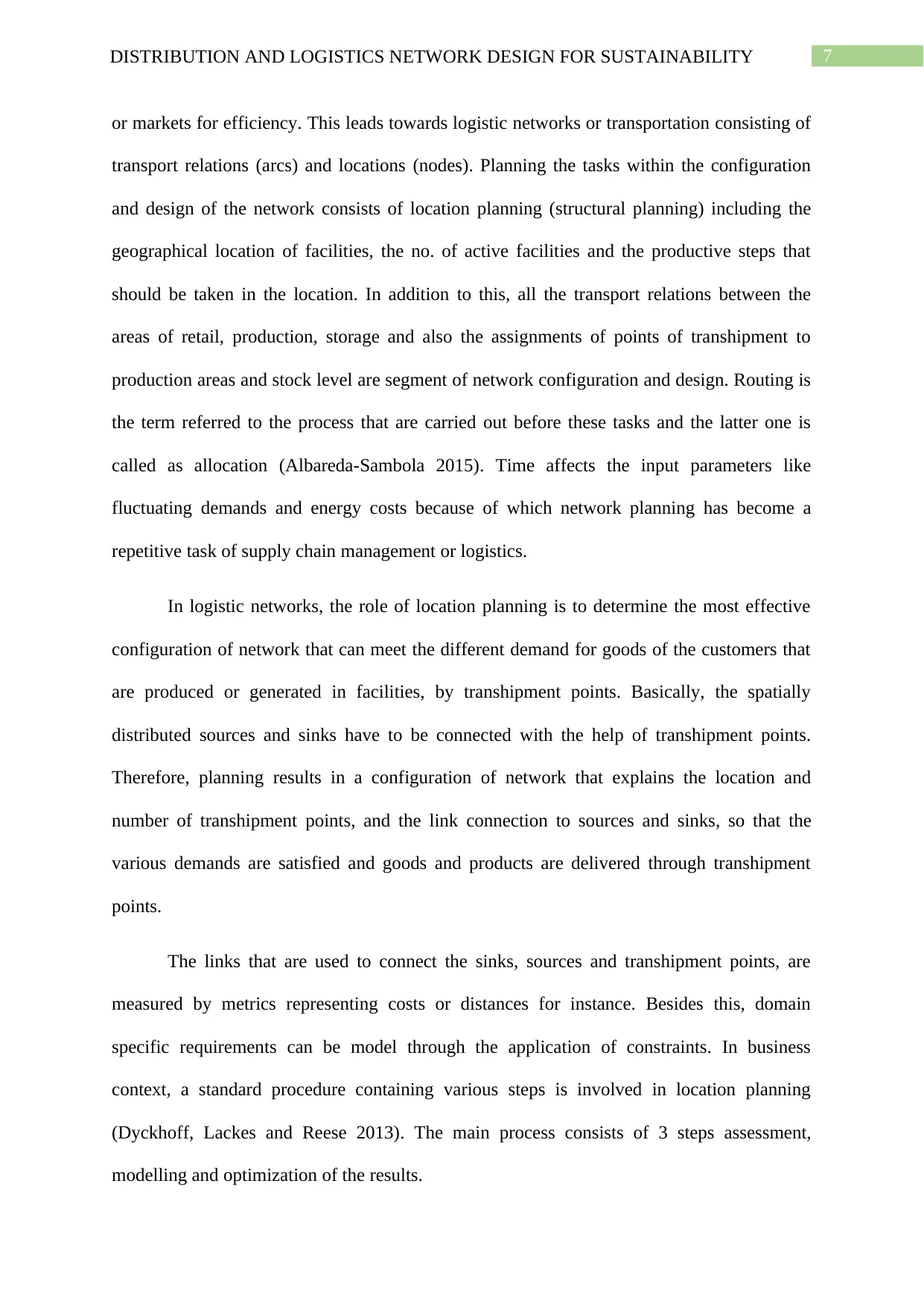
7DISTRIBUTION AND LOGISTICS NETWORK DESIGN FOR SUSTAINABILITY
or markets for efficiency. This leads towards logistic networks or transportation consisting of
transport relations (arcs) and locations (nodes). Planning the tasks within the configuration
and design of the network consists of location planning (structural planning) including the
geographical location of facilities, the no. of active facilities and the productive steps that
should be taken in the location. In addition to this, all the transport relations between the
areas of retail, production, storage and also the assignments of points of transhipment to
production areas and stock level are segment of network configuration and design. Routing is
the term referred to the process that are carried out before these tasks and the latter one is
called as allocation (Albareda-Sambola 2015). Time affects the input parameters like
fluctuating demands and energy costs because of which network planning has become a
repetitive task of supply chain management or logistics.
In logistic networks, the role of location planning is to determine the most effective
configuration of network that can meet the different demand for goods of the customers that
are produced or generated in facilities, by transhipment points. Basically, the spatially
distributed sources and sinks have to be connected with the help of transhipment points.
Therefore, planning results in a configuration of network that explains the location and
number of transhipment points, and the link connection to sources and sinks, so that the
various demands are satisfied and goods and products are delivered through transhipment
points.
The links that are used to connect the sinks, sources and transhipment points, are
measured by metrics representing costs or distances for instance. Besides this, domain
specific requirements can be model through the application of constraints. In business
context, a standard procedure containing various steps is involved in location planning
(Dyckhoff, Lackes and Reese 2013). The main process consists of 3 steps assessment,
modelling and optimization of the results.
or markets for efficiency. This leads towards logistic networks or transportation consisting of
transport relations (arcs) and locations (nodes). Planning the tasks within the configuration
and design of the network consists of location planning (structural planning) including the
geographical location of facilities, the no. of active facilities and the productive steps that
should be taken in the location. In addition to this, all the transport relations between the
areas of retail, production, storage and also the assignments of points of transhipment to
production areas and stock level are segment of network configuration and design. Routing is
the term referred to the process that are carried out before these tasks and the latter one is
called as allocation (Albareda-Sambola 2015). Time affects the input parameters like
fluctuating demands and energy costs because of which network planning has become a
repetitive task of supply chain management or logistics.
In logistic networks, the role of location planning is to determine the most effective
configuration of network that can meet the different demand for goods of the customers that
are produced or generated in facilities, by transhipment points. Basically, the spatially
distributed sources and sinks have to be connected with the help of transhipment points.
Therefore, planning results in a configuration of network that explains the location and
number of transhipment points, and the link connection to sources and sinks, so that the
various demands are satisfied and goods and products are delivered through transhipment
points.
The links that are used to connect the sinks, sources and transhipment points, are
measured by metrics representing costs or distances for instance. Besides this, domain
specific requirements can be model through the application of constraints. In business
context, a standard procedure containing various steps is involved in location planning
(Dyckhoff, Lackes and Reese 2013). The main process consists of 3 steps assessment,
modelling and optimization of the results.

8DISTRIBUTION AND LOGISTICS NETWORK DESIGN FOR SUSTAINABILITY
The optimization process within networks needs quantitative methods and the
development of mathematical model and input data like customer locations. The problem
incurred during optimization is called facility location fault under applied mathematics and
Operations Research (OR).
The metric influences the location planning outcome for two reasons. Firstly, it has a
major role in network configuration. Secondly, it acts as an indicator for the quality of the
model as it shows the congruency of the real world weighs and the model weighs, for
example costs. The metrics for measuring arcs signifies costs in logistic networks because of
two reasons: firstly, to receive information and data from the network model and secondly the
decisions can be structured on the basis of relevant parameters (Hammad, Akbarnezhad and
Rey 2016). However, As per the assumptions, costs are taken as distance’s linear function in
strategic network design. Then, for metrics for network design, costs are replaced by spatial
distances
Location planning
Planning of location plays a vital role in the formation of networks of supply chain.
There are various information regarding facility location with respect to transportation
network, which also includes ecological sustainability. The use of emission metrics and non-
linear cost is under develop till now.
Various papers were published based on ecological sustainability and non-liner
metrics. Works in management of supply chain, operations research and Applied
Mathematics portrays the multiple dimensions of the network design.
Amin and Zhang model featured plant location which consists of collection centres
(closed loop network) (Amin and Zhang 2013). Linear metric was applied and their model
The optimization process within networks needs quantitative methods and the
development of mathematical model and input data like customer locations. The problem
incurred during optimization is called facility location fault under applied mathematics and
Operations Research (OR).
The metric influences the location planning outcome for two reasons. Firstly, it has a
major role in network configuration. Secondly, it acts as an indicator for the quality of the
model as it shows the congruency of the real world weighs and the model weighs, for
example costs. The metrics for measuring arcs signifies costs in logistic networks because of
two reasons: firstly, to receive information and data from the network model and secondly the
decisions can be structured on the basis of relevant parameters (Hammad, Akbarnezhad and
Rey 2016). However, As per the assumptions, costs are taken as distance’s linear function in
strategic network design. Then, for metrics for network design, costs are replaced by spatial
distances
Location planning
Planning of location plays a vital role in the formation of networks of supply chain.
There are various information regarding facility location with respect to transportation
network, which also includes ecological sustainability. The use of emission metrics and non-
linear cost is under develop till now.
Various papers were published based on ecological sustainability and non-liner
metrics. Works in management of supply chain, operations research and Applied
Mathematics portrays the multiple dimensions of the network design.
Amin and Zhang model featured plant location which consists of collection centres
(closed loop network) (Amin and Zhang 2013). Linear metric was applied and their model
⊘ This is a preview!⊘
Do you want full access?
Subscribe today to unlock all pages.

Trusted by 1+ million students worldwide
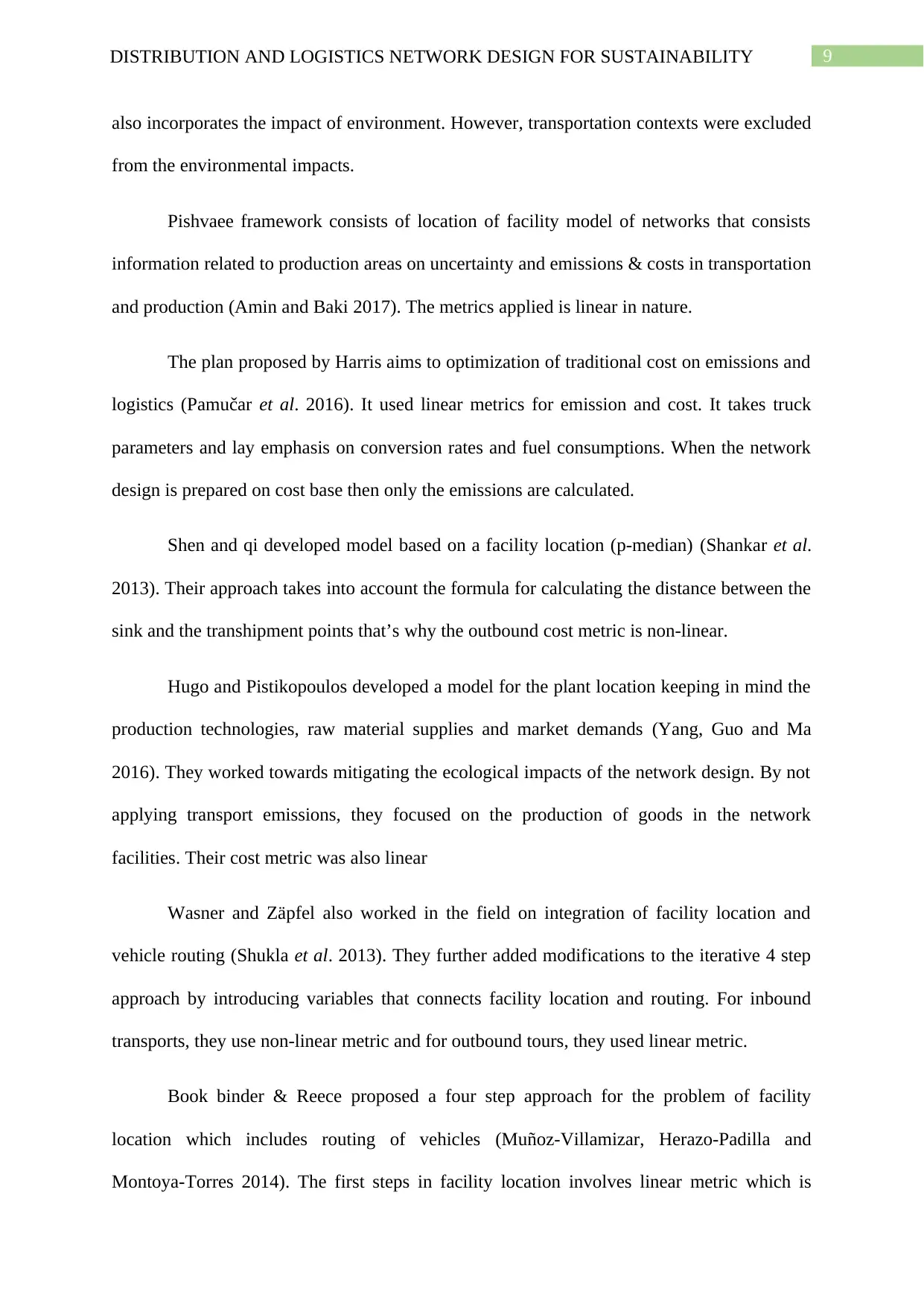
9DISTRIBUTION AND LOGISTICS NETWORK DESIGN FOR SUSTAINABILITY
also incorporates the impact of environment. However, transportation contexts were excluded
from the environmental impacts.
Pishvaee framework consists of location of facility model of networks that consists
information related to production areas on uncertainty and emissions & costs in transportation
and production (Amin and Baki 2017). The metrics applied is linear in nature.
The plan proposed by Harris aims to optimization of traditional cost on emissions and
logistics (Pamučar et al. 2016). It used linear metrics for emission and cost. It takes truck
parameters and lay emphasis on conversion rates and fuel consumptions. When the network
design is prepared on cost base then only the emissions are calculated.
Shen and qi developed model based on a facility location (p-median) (Shankar et al.
2013). Their approach takes into account the formula for calculating the distance between the
sink and the transhipment points that’s why the outbound cost metric is non-linear.
Hugo and Pistikopoulos developed a model for the plant location keeping in mind the
production technologies, raw material supplies and market demands (Yang, Guo and Ma
2016). They worked towards mitigating the ecological impacts of the network design. By not
applying transport emissions, they focused on the production of goods in the network
facilities. Their cost metric was also linear
Wasner and Zäpfel also worked in the field on integration of facility location and
vehicle routing (Shukla et al. 2013). They further added modifications to the iterative 4 step
approach by introducing variables that connects facility location and routing. For inbound
transports, they use non-linear metric and for outbound tours, they used linear metric.
Book binder & Reece proposed a four step approach for the problem of facility
location which includes routing of vehicles (Muñoz-Villamizar, Herazo-Padilla and
Montoya-Torres 2014). The first steps in facility location involves linear metric which is
also incorporates the impact of environment. However, transportation contexts were excluded
from the environmental impacts.
Pishvaee framework consists of location of facility model of networks that consists
information related to production areas on uncertainty and emissions & costs in transportation
and production (Amin and Baki 2017). The metrics applied is linear in nature.
The plan proposed by Harris aims to optimization of traditional cost on emissions and
logistics (Pamučar et al. 2016). It used linear metrics for emission and cost. It takes truck
parameters and lay emphasis on conversion rates and fuel consumptions. When the network
design is prepared on cost base then only the emissions are calculated.
Shen and qi developed model based on a facility location (p-median) (Shankar et al.
2013). Their approach takes into account the formula for calculating the distance between the
sink and the transhipment points that’s why the outbound cost metric is non-linear.
Hugo and Pistikopoulos developed a model for the plant location keeping in mind the
production technologies, raw material supplies and market demands (Yang, Guo and Ma
2016). They worked towards mitigating the ecological impacts of the network design. By not
applying transport emissions, they focused on the production of goods in the network
facilities. Their cost metric was also linear
Wasner and Zäpfel also worked in the field on integration of facility location and
vehicle routing (Shukla et al. 2013). They further added modifications to the iterative 4 step
approach by introducing variables that connects facility location and routing. For inbound
transports, they use non-linear metric and for outbound tours, they used linear metric.
Book binder & Reece proposed a four step approach for the problem of facility
location which includes routing of vehicles (Muñoz-Villamizar, Herazo-Padilla and
Montoya-Torres 2014). The first steps in facility location involves linear metric which is
Paraphrase This Document
Need a fresh take? Get an instant paraphrase of this document with our AI Paraphraser

10DISTRIBUTION AND LOGISTICS NETWORK DESIGN FOR SUSTAINABILITY
followed by the second step, vehicle routing. Their study inferred that metric of location of
facility is linear while overall metric is non-linear.
Author Year Non-linear
metric
Robustness/
Uncertainty
Ecological
sustainability
Industrial
applications
Amin and
Zhang
2012 - x x (Show case)
Pishvaee 2012 - x x Medical
Harris 2011 - - x Automations
Shen and Qi 2007 x - - 4 generated
data sets
Hugo and
Pistikopoulo
s
2005 - - x (Show case)
Wasner and
Zäpfel
2004 x - - Distribution of
parcel
Book-binder
&
Reece
1988 x - - (Show case)
Table 1: Study by various researchers on sustainability and location planning
followed by the second step, vehicle routing. Their study inferred that metric of location of
facility is linear while overall metric is non-linear.
Author Year Non-linear
metric
Robustness/
Uncertainty
Ecological
sustainability
Industrial
applications
Amin and
Zhang
2012 - x x (Show case)
Pishvaee 2012 - x x Medical
Harris 2011 - - x Automations
Shen and Qi 2007 x - - 4 generated
data sets
Hugo and
Pistikopoulo
s
2005 - - x (Show case)
Wasner and
Zäpfel
2004 x - - Distribution of
parcel
Book-binder
&
Reece
1988 x - - (Show case)
Table 1: Study by various researchers on sustainability and location planning

11DISTRIBUTION AND LOGISTICS NETWORK DESIGN FOR SUSTAINABILITY
Source: created by the author
Concept of sustainable supply chain
The sustainable supply chain comprises of key terms i.e. sustainability and supply
chain. The supply chain refers to set of elements involved in flows (upstream and
downstream) of service, product, finance and data from source to customer (Darmawan, Putra
and Wiguna 2014). Another key term for sustainability are organisational sustainability
which consist of three elements are: society, economic performance and natural environment,
these are the elements that organisations can undertake that positively affects the society and
natural environment, which has a long term economic benefit and competitive advantages of
the companies. Initially, sustainable development was to integrate environmental friendly
problems in the management of supply chain (Youn et al 2013). Therefore such term like
green chain supply, closed loop chain supply were in common use.
The term green is used in management of supply chain to combine environment and
create awareness in all operations of supply chain management which includes green material
management, reverse logistics, green manufacturing, green marketing, and green distribution.
It also assess in waste reduction in every stages of supply chain and it also involves product
management in management of supply chain. Green supply chain includes product recovery
and product end life in closed loop and reverse supply chains (Diabat, Khodaveri and Olfat
2013). Product return services are available in reverse supply chain if backward flows
happens from customer to source . The product that are returned can be recovered in the
forward supply chain. Reverse and forward supply chain both comes under the closed loop
supply chain.
Source: created by the author
Concept of sustainable supply chain
The sustainable supply chain comprises of key terms i.e. sustainability and supply
chain. The supply chain refers to set of elements involved in flows (upstream and
downstream) of service, product, finance and data from source to customer (Darmawan, Putra
and Wiguna 2014). Another key term for sustainability are organisational sustainability
which consist of three elements are: society, economic performance and natural environment,
these are the elements that organisations can undertake that positively affects the society and
natural environment, which has a long term economic benefit and competitive advantages of
the companies. Initially, sustainable development was to integrate environmental friendly
problems in the management of supply chain (Youn et al 2013). Therefore such term like
green chain supply, closed loop chain supply were in common use.
The term green is used in management of supply chain to combine environment and
create awareness in all operations of supply chain management which includes green material
management, reverse logistics, green manufacturing, green marketing, and green distribution.
It also assess in waste reduction in every stages of supply chain and it also involves product
management in management of supply chain. Green supply chain includes product recovery
and product end life in closed loop and reverse supply chains (Diabat, Khodaveri and Olfat
2013). Product return services are available in reverse supply chain if backward flows
happens from customer to source . The product that are returned can be recovered in the
forward supply chain. Reverse and forward supply chain both comes under the closed loop
supply chain.
⊘ This is a preview!⊘
Do you want full access?
Subscribe today to unlock all pages.

Trusted by 1+ million students worldwide
1 out of 20
Related Documents
Your All-in-One AI-Powered Toolkit for Academic Success.
+13062052269
info@desklib.com
Available 24*7 on WhatsApp / Email
![[object Object]](/_next/static/media/star-bottom.7253800d.svg)
Unlock your academic potential
Copyright © 2020–2025 A2Z Services. All Rights Reserved. Developed and managed by ZUCOL.





